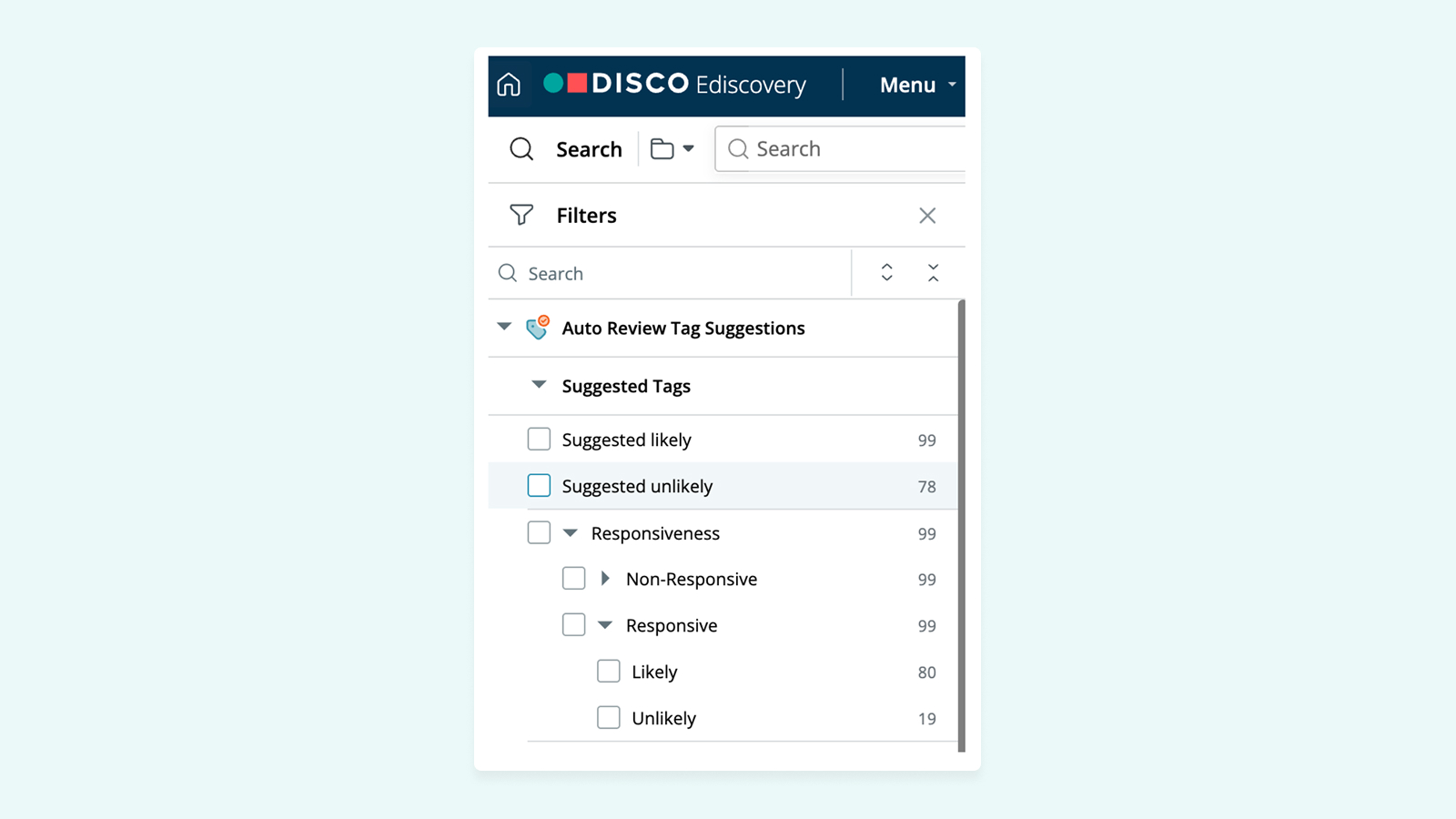⚡️ 1-Minute DISCO Download
Generative AI for litigation and discovery
DISCO established its AI Lab in 2015 and since then, used its AI for document prioritization to drive value for its numerous clients. This is because since inception, DISCO recognized the critical role that AI will play in the practice of law. A 2022 IBA research report states that 40% of young lawyers believe AI and legal technology is critical to the future of their profession, which confirmed DISCO's vision.
As the next evolution of AI, generative AI -- although relatively new to the game -- is taking tech-enabled litigation and discovery to new heights. This article will discuss the benefits of utilizing generative AI for discovery, address the risks that corporate legal teams may encounter, and provide potential remedies to mitigate those risks.
Why use generative AI for litigation and discovery?
Key benefit: Rapidly summarize complex information
As the channels we use for communication have grown more technical and complex, so has discovery.
The complexity stems not only from the proliferation of various communication methods (such as short-form messaging applications like Slack and Microsoft Teams, virtual conferencing tools like Zoom, ephemeral messaging like Signal and Snapchat, social media, and more) but also from the accelerating volume of information that organizations produce in the course of day-to-day operations.
For corporate legal teams, which tend to run lean, the daunting prospect of reviewing such a high number of documents often means that outside counsel must be engaged.
Generative AI is changing that.
Generative AI can easily perform tasks that would otherwise be a huge lift for human legal teams, cutting through massive data sets to present attorneys with fully cited timelines and links to the most relevant documents, all in response to natural-language queries.
This offers the clear benefit of saving time and money. But perhaps the biggest strategic advantage of using generative AI in the discovery stage is the ability to understand cases and set strategy from the jump.
Being able to assess risk as quickly as possible means you can advise whether to settle or not, or whom to depose first. Without a generative AI tool, initial document review often begins in the dark, with relevant facts becoming clear only many days into the review.
DISCO’s Vice President of Product Strategy, Katie DeBord explains, “Generative AI helps set up strategy more quickly, and assess risk as fast as possible so the legal team can advise clients whether to settle or not. It can also help decide who to depose first – a major strategic advantage.”
Related reading: The Costs vs. Benefits of Using Deposition Videos in Your Cases 💡
Example: Generative AI-powered litigation and discovery in action
Acme Industries has been hit with a class-action lawsuit, alleging that a significant number of Widget Xs overheated, damaging some users’ property.
The complaint further alleges that Acme leadership were aware of Widget X’s propensity to overheat, but in their haste to get Widget X to market, opted not to redesign the product or conduct thorough safety checks.
As this appears to be a complex litigation, our general counsel, Claire, discusses the matter with Acme’s outside counsel. She is told the firm will require several weeks – and a high number of estimated billable hours – to complete preliminary document review.
She is also told the firm won’t be able to advise Acme on strategy until the review is well underway.
So, Claire uses a generative AI tool to help her team interrogate the available data.
Her team focuses their search on custodians who worked in Acme’s engineering and product divisions, querying the AI for relevant communications. Very quickly, the team uncovers that most of the key discussions happened in the spring prior to Widget X’s release. This enables them to focus on those specific segments of the data as they seek relevant information.
Within the day, the legal team finds conversations between certain members of the design team, acknowledging that Widget X might overheat if used improperly. Claire advises Acme to settle the suit, thereby avoiding a long and costly litigation.
Using generative AI for litigation and discovery: Risks and solutions
Risk: Inaccuracy and missing information
Attorneys can worry that if they don’t review every single document manually, they’ll miss a golden nugget of information that could be vital to their case.
Solution: Hybrid AI-human review approach
Use a generative AI solution like DISCO’s Cecilia that provides in-line citations and links to relevant documents, with pertinent sections highlighted. With a tool that literally points to the source of its response, the human user can verify the AI’s conclusion.
This is extremely helpful for answering targeted questions about the data before review has even begun.
However, if a team needs to review the entire body of documents, they can radically increase efficiency with a hybrid AI-human review approach, like Cecilia Auto Review.
If the team decides that the documents are perfectly categorized, the rest of the document population can be auto-reviewed; otherwise, the prompt may be adjusted – perhaps to be more or less inclusive – and the process will be iterated until the team is satisfied with the AI’s results. Only then will the tool be run on the entire document set.
It is important to note that the same kinds of quality controls that have traditionally been a part of TAR 2.0 reviews can be applied to Auto Review. By layering in estimation samples, validation samples, and other kinds of statistical sampling — either on their own or in partnership with a service like DISCO’s managed review — attorneys can feel even more confident in the results.
Even if outside counsel must be engaged, generative AI can assist in reducing the spend of time and resources.
Related reading: Solutions for Legal Departments 💡
Risk: Ethical and privacy hurdles
Legal professionals are required to adhere to strict ethical standards, which include supervising non-lawyer employees and retaining all responsibility for the legal work done on behalf of clients. Maintaining data privacy is also a paramount concern.
Solution: Ethical and privacy hurdles
The good news is, technology-assisted legal workflows have long been approved by courts, notably in Da Silva Moore v. Publicis Groupe, 287 F.R.D. 182 (S.D.N.Y. 2012). Generative AI may be novel, but it follows a long precedent of AI being regarded as an accepted – even integral – element of good legal representation.
Make sure any tool you use for AI ediscovery is designed to comply with relevant data protection regulations. Hosted on AWS global infrastructure, DISCO’s tech upholds the highest standards for privacy and data security. This level of compliance, including SOC2 Type 2 and ISO 27001 certification, as well as GDPR compliance, ensures that sensitive client data is protected at all times.
In addition, consider selecting a partner who is familiar with legal precedent regarding the use of AI and experienced in managing AI-assisted projects. The DISCO Review team is made up of experts who have been running AI-powered reviews for more than a decade.
Not a DISCO user? Ask your vendor to articulate their strategy for creating efficiencies with AI.
Adopting generative AI for litigation and discovery: Actionable next steps
- Focus on data privacy and ethical compliance
Implement strict guidelines and data protection measures in your ediscovery process. Select a vendor who is familiar with applicable data protection regulations and ensure that your chosen generative AI system is hosted in an environment that safeguards the privacy and security of your clients’ data.
- Establish clear protocols for reporting AI usage
Certain legal jurisdictions require disclosure of AI usage and purpose. Establish clear protocols. For example, you could specify that certain information must be recorded — such as the specific AI tools used, the purpose of their usage, and the outcomes achieved.
Ready to start using Generative AI for litigation?
Looking to streamline your document review process? DISCO is here to help.
DISCO’s top of the line ediscovery platform is user-friendly, featuring advanced search visualization, strong data organization, and a highly secure infrastructure. And now, DISCO’s Cecilia AI is taking litigation to the next level with Cecilia Q&A (the AI assistant that can answer any case related question), Cecilia Timelines (automatically generated timelines and summarize key facts about your case), and Cecilia Auto Review – plus, more development to come.
See how we can transform your practice: Request a demo.
This article comes from our downloadable ebook, Generative AI for Corporate Legal Teams: What You Really Need to Know.
Check out the other articles in this series:






%20(1).jpeg)









